

The Triumph Herald was a small two-door car introduced in 1959 by the Standard Triumph Company. Body design was by the Italian stylist Giovanni Michelotti and the car was offered in saloon, convertible, coupe, van and estate variants.
Towards the end of the 1950s, Standard-Triumph were enjoying great success with their range of 2-seater Triumph sports cars which they offered alongside their range of Standard saloons. The small car in the range was the Standard 8/10, powered by a small 4-cylinder engine and completing with the Morris Minor, Ford Popular and Austin A35. However the rather dumpy looking Standard had never been a huge success, and by the late 1950s was due for an update; Standard Triumph therefore started work on the Herald.
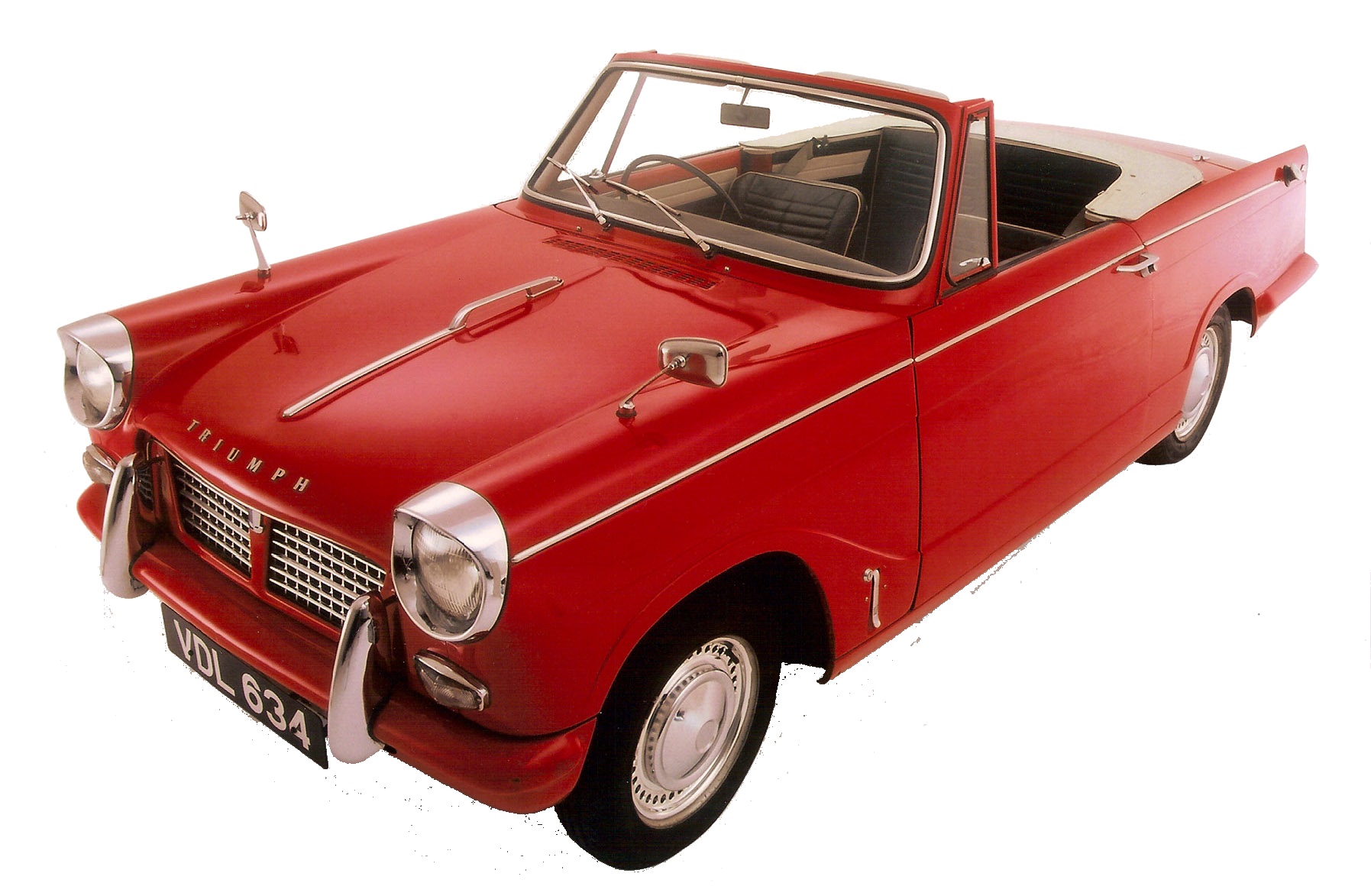 |
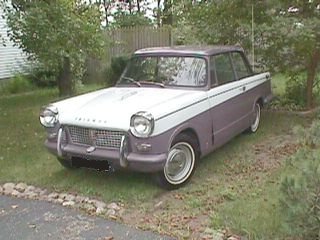 |
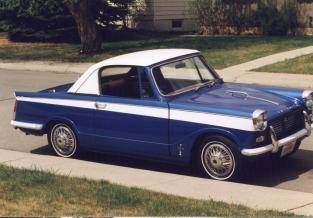 |
| 1960 948cc Herald Convertible | 1960 948cc Herald Saloon | 1961 948cc Herald Coupe |
The Italian designer Michelotti was commissioned to style the car, and he quickly came up with designs for a pretty two-door saloon with a large glass area. The Company decided from the start that the new small car should have a separate chassis rather than a monocoque construction, even though this was beginning to look outmoded by the late 1950s. The main body tub was bolted to the chassis, and the whole front end hinged forward to allow access to the engine. Every panel - including the sills and roof - could be unbolted from the main car. This method of construction had certain advantages, not least that different body styles could be easily substituted on the same basic chassis: accordingly, coupe, convertible and estate versions were all on offer within two years.
Mechanically, the new Herald was a mixture of traditional and modern. The Standard 8's 4-cylinder OHV engine was used in 948cc form, mated to a 4 speed gearbox with synchromesh on the top three gears and driving the rear wheels. The excellent steering was by rack and pinion (affording the car a 25-foot turning circle), with coil and wishbone front suspension. The rear suspension was a brand new departure for Triumph, offering independent springing via a single transverse leaf spring.
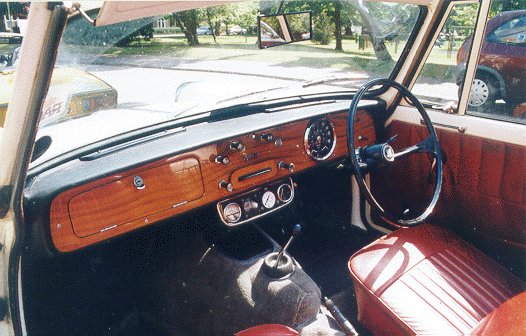 |
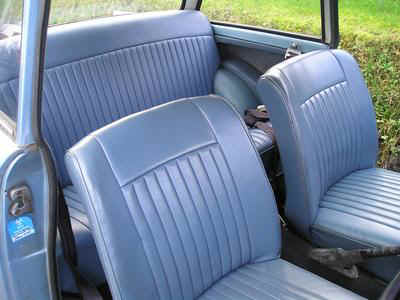 |
| 1961 948cc Dash Board with extra gauges | 1960 948cc Upholstery |
Interior shots from the Herald range
The styling was sharp and modern and the interior light and airy, thanks to the large glass area. Instruments were confined to a single large speedometer incorporating fuel gauge (a temperature gauge was available as an option), and the dashboard of grey pressed fibre. The car was reasonably well equipped with standard carpeting and heater. The Herald was offered in a variety of bright modern colours and a number of extras were available, including twin carburetors, front disc brakes and sunroof.
The new car was fairly well-received, but was not an immediate sales success. It was a little more expensive than some of its competitors, and the separate chassis resulted in lots of creaks, groans and thumps from the flexible structure. In standard single carburetor form the car was no better than average in terms of performance, with 60mph coming up in about 22 seconds and a maximum speed of 80mph. The new rear suspension was also criticised for leading to tricky handling on the limit. On the plus side, the car was considered easy to drive with light steering and controls, and excellent visibility.
The Herald 1200
Standard-Triumph had staked a lot on their new car; the Company was in serous financial trouble at the beginning of the 1960s, and was taken over by the expanding Leyland organisation in 1961. This released new resources to develop the Herald, and the car was re-launched with an 1147cc engine as the Herald 1200. The new model featured numerous detail improvements, including white bumpers, a wooden dashboard and improved seating; quality control was also tightened up. The new car was much more pleasant to drive, and sales picked up, despite growing competition from the BMC Mini and the Ford Anglia.
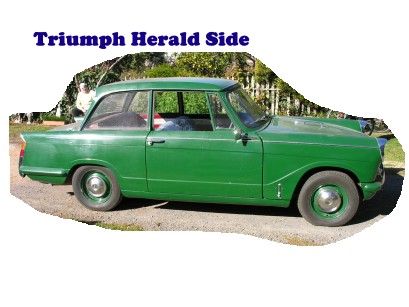 |
The other versions of the Herald were also selling well; the convertible was popular as a genuine 4-seater with decent weatherproofing, and the estate made a practical alternative to the Morris Traveler, despite its somewhat boxy styling. The coupe was withdrawn soon after the introduction of the 1200 however, having been somewhat less successful. The Triumph Courier van - basically a stripped-down Herald estate with no rear side windows - also fell from the range after extremely poor sales. A sportier version, the 12/50, was offered from 1963 -1967 and featured a tuned engine, sliding fabric sunroof and standard front disc brakes.
The Herald 12/50 - Courtesy Unique Cars - Feature Cars
Australian Motor Industries (AMI) was under greater threat than most by the credit squeeze that decimated local car sales in 1961. The much-needed six for its ageing Standard Vanguard was too little, too late, and local conditions had already exposed early Triumph Herald shortfalls.
To stay afloat, AMI sold its share in the hard-won Mercedes-Benz franchise back to the parent company, then staked its long-term future on the unknown Toyota brand while establishing its new Rambler franchise. But erasing the Herald taint from Triumph's cut-above sports positioning was a more immediate worry as the trusty Vanguard nameplate and range were about to disappear forever.
Before the game-changing Toyota Corona arrived, AMI had barely a year's headstart to launch a unique Australian version of the Triumph Herald. At its release in January 1964, that car was the world's best four-cylinder Herald.
Called 12/50, without a Herald badge in sight, it was much more desirable in areas where the Herald wasn't. Along with the Spitfire and TR4 sports cars, the new 12/50 was vital to fast-tracking Triumph credibility in preparation for the stunning Triumph 2000 that arrived hot on its heels. Even if the sales figures say otherwise, the 12/50 succeeded and changed the way Aussies perceived both the Herald and Triumph.
Launched initially as a 2+2 Coupe only, then heavily promoted as a blood brother to the Spitfire, it offered "sports car sparkle in a luxury coupe", according to AMI, for less than $2000, or just slightly more than a VW 1200 Beetle. It was followed by a four-seat Saloon version in April '64.
The British 12/50 was a tricked-up Herald, but the local 12/50 went far beyond that. Unknown to most Australians, Triumph UK had shoe-horned a tiny 1.6-litre version of the new Vanguard six into the Herald to create the Vitesse. Visually, the Vitesse was a class act after Michelotti, who styled the original Herald, came up with an aggressive new four-headlight front. The Vitesse pre-empted Holden's six-cylinder LC Torana by seven years, but it was a premium-priced wood-and-carpet model that would have cost $2700 - Holden Premier money - in Oz. That didn't stop an English woman, a Miss P Hay, from bringing one with her to Australia and impressing the Wheels team in 1963, who found little to criticise.
Barely six months later, the same aggressive styling emerged here on the Aussie four-cylinder 12/50 model for less than $2000. It was worthy of a Wheels cover because back then, quad headlights were still a top-shelf feature. Michelotti's Vitesse front drew on some heavy-hitters including the Gordon Keeble, the 'China Eyes' Rolls-Royce Silver Cloud III/Bentley S3-based coupes, and the Ferrari 330 GT. The 12/50 also delivered unprecedented headlight performance for its price, in a market where such things mattered.
Because the Herald's bonnet and front guards folded forward as a single unit, all AMI had to do was order its Triumph 12/50 CKD kits minus the front section, then attach the Vitesse bonnet during assembly. But the clever part was lifting local cabin, suspension and structural quality to somewhere in between the Spitfire and Vitesse. On paper and on the road, the 12/50 was the perfect curtain raiser for the imminent Triumph 2000, even if its lack of rear doors would ultimately kill sales.
The flood of cheap, well-equipped, four-headlight, four-door Japanese models, all with bigger engines and all due by the end of 1964, defined the 12/50's model life. For AMI, this was of no concern as it was the first and only Australian company that had this base covered. Locally-assembled Corona sales bolted as 12/50 sales faltered.
Just 27 Coupe examples were built late in 1963 for launch, followed by 93 in 1964 and 24 in 1965. The Saloon fared better with 202 built in 1964, despite its later arrival, then 80 in 1965 and six examples carried over into 1966, for a combined total well short of 500. Exclusivity was a given with the 12/50 and that is why this important model is all but forgotten today.
To appreciate what AMI achieved with the 12/50, it helps to know what they were working with. Its Herald starting point was AMI's 1959 replacement for the dependable local version of the old Standard 10. The Herald was an answer to the same question that produced the first Cortina, except Ford opted for a cheap but relatively tight unitary bodyshell.
Triumph built the Herald from bolt-together modules stacked on a basic square-section chassis, with multiple body styles that involved little more than swapping different roofs. Damaged body panels were easily unbolted and replaced, and the separate chassis avoided the rot-prone unitary box sections that were killing rivals, such as the Morris Minor, prematurely. The Herald's front suspension, rack-and-pinion steering module and its steering column were deemed good enough for the iconic Lotus Elan.
Mindful of global VW Beetle success, the Herald was given swing-axle rear suspension with a simple transverse leaf spring. Despite this design's tendency for the rear wheels to clap hands and roll the car during hard cornering, it worked better in the Herald thanks to the lack of a pendulum effect from a rear-mounted engine. General driving ease, vision, ride and handling were a revelation for a 1959 small car. Herald was an instant success. So what went wrong?
Triumph had to slash weight wherever possible to allow for the separate chassis. New fibreboard sections, too close to cardboard, replaced metal parts no longer important structurally. This included the dashboard. Because the Herald was built like a giant Meccano set, it had no chance of resisting the constant twisting and impacts that Australian roads fed into the car. This not only loosened the body, but exposed the cardboard parts to stresses and climate extremes they were never intended to face.
For an urban Australian in 1959, the Herald was a star with its perky performance, ease of maintenance, tight turning circle, great vision, Italian style and refined ride. But beyond city limits, it almost fell apart before your eyes - a disaster given the expectations of rural owners generated by the Standard 10 and Vanguard.
Adding Spitfire panels to this structure was simple, except by then Triumph knew it had to re-engineer the Herald chassis if it was going to survive sports-car stresses. Every supporting section was beefed-up and the suspension was strengthened and stiffened, especially the rear, to make it more resistant to camber change.
AMI simply specified the lot for the 12/50, including most of the Spitfire's upgrades for the 1147cc engine, close-ratio gearbox and front disc brakes. To maintain the Herald's exceptional fuel economy, a single carburettor was fitted. Power jumped from 39hp (about the same as a VW) to 51hp (more than a Cortina). For a sub-1.2-litre, these were adult horses, not Japanese ponies, so the 12/50 was quick, with stopping power to match.
Plusher pleated seats, extra carpet, a vinyl-covered dash, a proper heater-demister, separate gauges, full wheel trims, and headlight/high-beam controls mounted on the steering column all added to the cut-above feel. Apart from a subtle reversal in the front parking/indicator light sections, the local 12/50 was indistinguishable externally from a Vitesse. It was easy for a keen driver to maintain and upgrading it with a Spitfire engine or any number of versions of the Vanguard/Triumph six was simple too.
For Australians, the 12/50 was the car that many desired, but needs dictated a four-door Cortina, Corona or Morris 1100 - a process that would kill the Aussie-built Beetle a year later. It's why a good 12/50 (or Herald) will still generate interest today among those revisiting that choice.
Even if the 12/50 marked the end of small Triumphs built in Australia, its simple, bolt-together construction ensured that it lived on as a four-door in India.
Click here for another article, this time by Dale Hickman, Tasmanian 12/50 export owner
The Herald 13/60
In 1967, the Herald range was updated with the introduction of the 13/60. The front end was restyled to give a sleeker, more modern appearance and the interior substantially revised, though still featuring the traditional wooden dashboard. The engine was enlarged to 1296cc, offering 61bhp and much improved performance; the gearbox was updated with an all-synchromesh unit and front disc brakes made standard. In this form (though the 1200 was sold alongside it until 1970) the Herald lasted until 1971, by which time it was severely outdated. It had already outlived the introduction of the Triumph 1300, the car designed to replace it, and was still selling reasonably well, but it no longer had a place among the range of newer cars in the Leyland line-up.
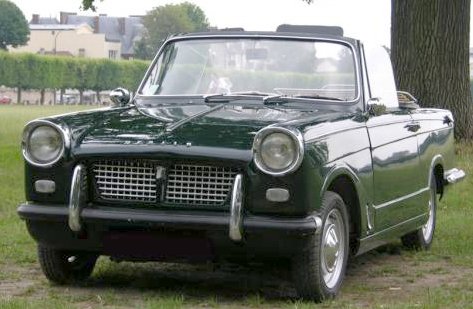 |
| Convertible |
The decision of Triumph to build a new small car in the late 1950s paid off handsomely. Total Herald sales numbered well over 300,000, thanks in no small part to the number of variants made possible by its separate chassis design. Saloon, convertible, estate, coupe and van were only a small part of the Herald's total contribution to the Standard-Triumph range: the Triumph Vitesse, Triumph GT6 and Triumph Spitfire were all based around modified Herald chassis with bolt-together bodies and were hugely successful for the company.
Today, there remains a large number of surviving Heralds in the all over the World with keen enthusiast support. The most common surviving Heralds are the saloons and convertibles; estates are now getting rare, and the coupe is extremely scarce. Rarest of all is the Courier van, with only a handful of known survivors. Always popular with driving schools, the cars evoke a strong nostalgia from the great many people who learned to drive or drove everyday in the little Triumph. Though it came too late to save Standard-Triumph as an independent company, the Triumph Herald forms an important chapter in Britain's motoring heritage.
Triumph Vitesse
The 1962 Triumph Vitesse took its name from a famous pre-war model and revived the genre of the Light Six, being powered by a 1.6-litre version of the Vanguard Six engine. The sporting specification included front disc brakes and a close ratio gearbox. With a weight of just17cwt, the Vitesse was quite a performer and capable of out-accelerating a number of sports cars on offer at the time. During 1966, the engine was enlarged to 2 litres, further boosting the performance, whilst the following year the rear suspension was revised, giving much improved handling and enabling the Vitesse to retain its composure when driven briskly on a twisty road. The Mark 2 Vitesse looked like an upmarket Triumph Herald, but drove like a sports car, able to outrun many more expensive and highly regarded sports cars of the day.
In 1959 when Standard-Triumph introduced the Standard Herald, they also conceived of a six-cylinder "power" version. Triumph engineers shoe-horned a 2-litre version of this six into a modified Herald. The Italian designer Giovanni Michelotti conceptualised new front styling and the car was given a reworked, sturdier chassis frame than the Herald.
The result was a potent sporting saloon with its 2-litre engine giving 160 km/h performance. In its day it was more than a match for the MGB or Sunbeam Alpine, and was marketed to the sports car enthusiast with a growing family. The Vitesse was launched in 1962 with a 1600 cc six-cylinder twin Solex carburettured engine that developed 70 bhp @ 5000 rpm and 125 Nm torque @ 2800 rpm. With a traditionally British interior: full instrumentation and lavish wood veneers, it was offered in Saloon and Convertible versions.
In 1965, the Solex's were replaced by two Zenith-Stromberg sidedraft carburetors which significantly increased horsepower, acceleration and fuel economy.
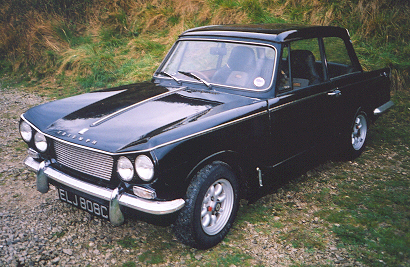 |
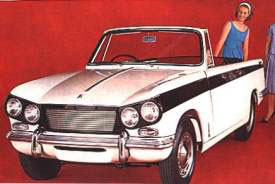 |
| Vittesse MkII | Vittesse MkI Convertible |
In 1966, the Vitesse became a true 2-litre car with an upgrade to a 1998 cc motor that developed 95 bhp @ 500 rpm and 160 Nm torque @ 3000 rpm. It had all-synchromesh transmission, sturdier axles and differential, larger front disc brakes, and the 4.5" wide wheels.
The swing-axle rear suspension, so familiar to us in the Herald, had severe limitations. The 1968 Vitesse 2-litre Mark 2 had instead, a double-jointed half axle setup, utilizing the same transverse spring but adding a lower wishbone and Rotoflex couplings and relocated trailing arm and shock absorbers. The Rotoflex-equipped independent rear suspension greatly improved handling over the Herald.
The last Vitesse was built in May 1971.
Production figures
| Herald 948 saloon | 1959 - 1962 | All variants | 76,860 |
| Herald 948 convertible | 1960 - 1961 | All variants | 8,262 |
| Herald coupe | 1959 - 1961 | All variants | 15,153 |
| Herald 1200 | 1961 - 1970 | Saloon | 201,142 |
| Coupe | 5,319 | ||
| Convertible | 43,295 | ||
| Estate | 39,819 | ||
| 12/50 | 1963 - 1967 | All variants | 53,267 |
| 13/60 | 967 - 1971 | All variants | 82,650 |
| Vitesse 1600/Sports 6 | 1962 - 1966 | Both Variants | 31,261 |
| Vitesse MkI | 1966 - 1968 | Both variants | 10,830 |
| Vitesse MkII 2 Litre | 1968 - 1971 | Both variants | 9,121 |